Abstract
The genetic features of eight families with autosomal dominant late onset cerebellar ataxia with randomly distributed associated clinical features are described. The ratio of affected to unaffected offspring of affected subjects was not significantly different from 1:1. The mutant gene was fully penetrant when cases who died before the period of risk of developing the disease were excluded. The proportion of new mutants with this disorder appears to be low. Biological fitness was not impaired. Affected females tended to have large families than affected males. The ages of onset of females and males were not significantly different, but the offspring of affected males had earlier ages of onset and death than those of affected females. A cumulative age of onset curve is presented which should aid genetic counselling of subjects at risk and their children.
Full text
PDF
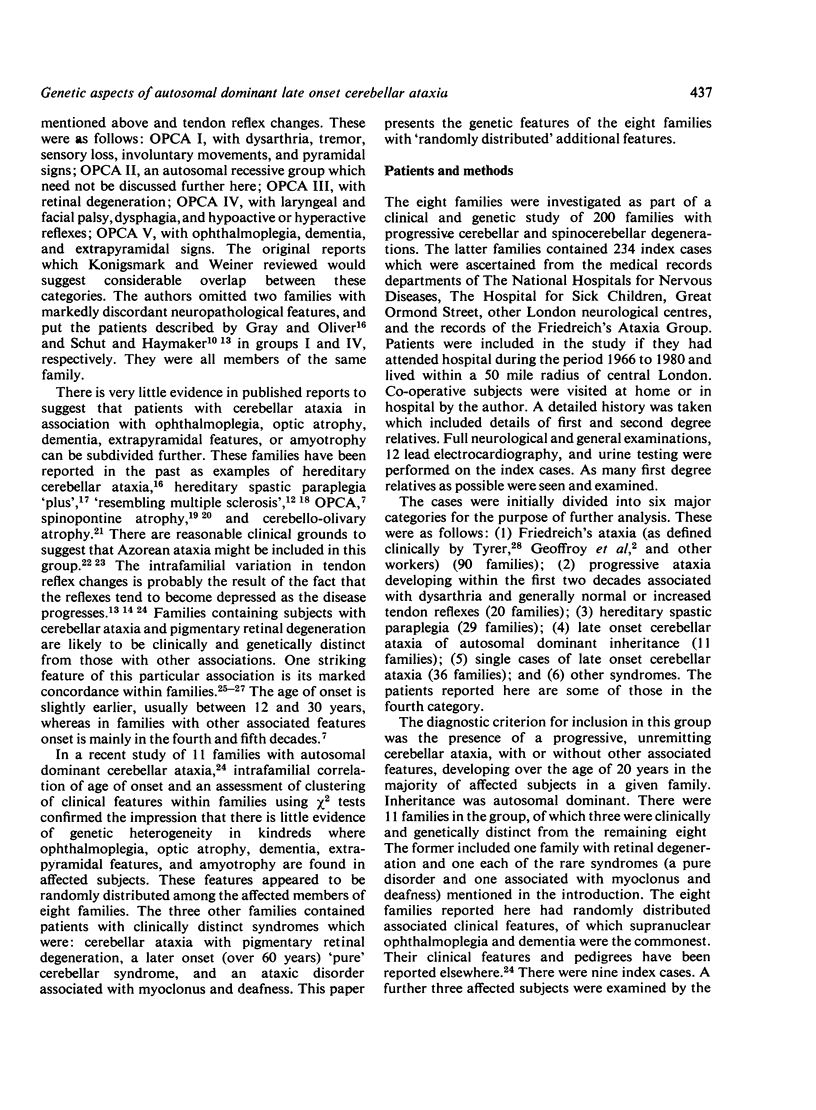
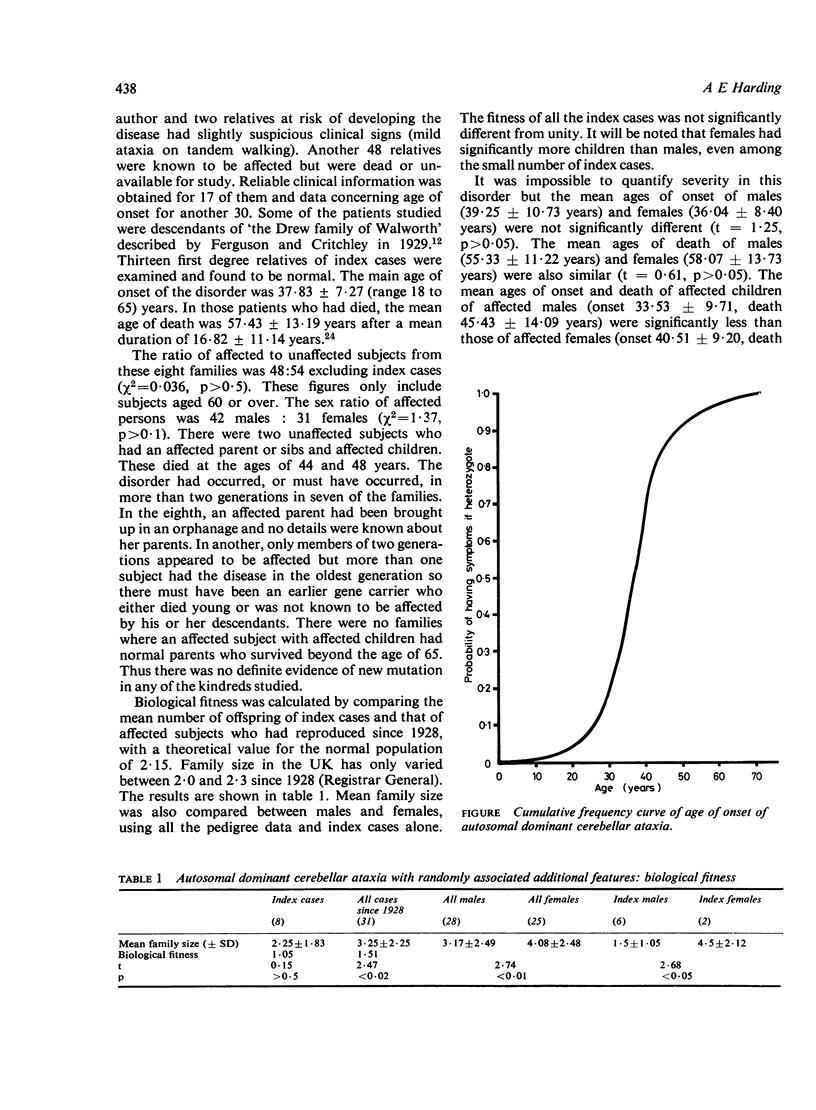
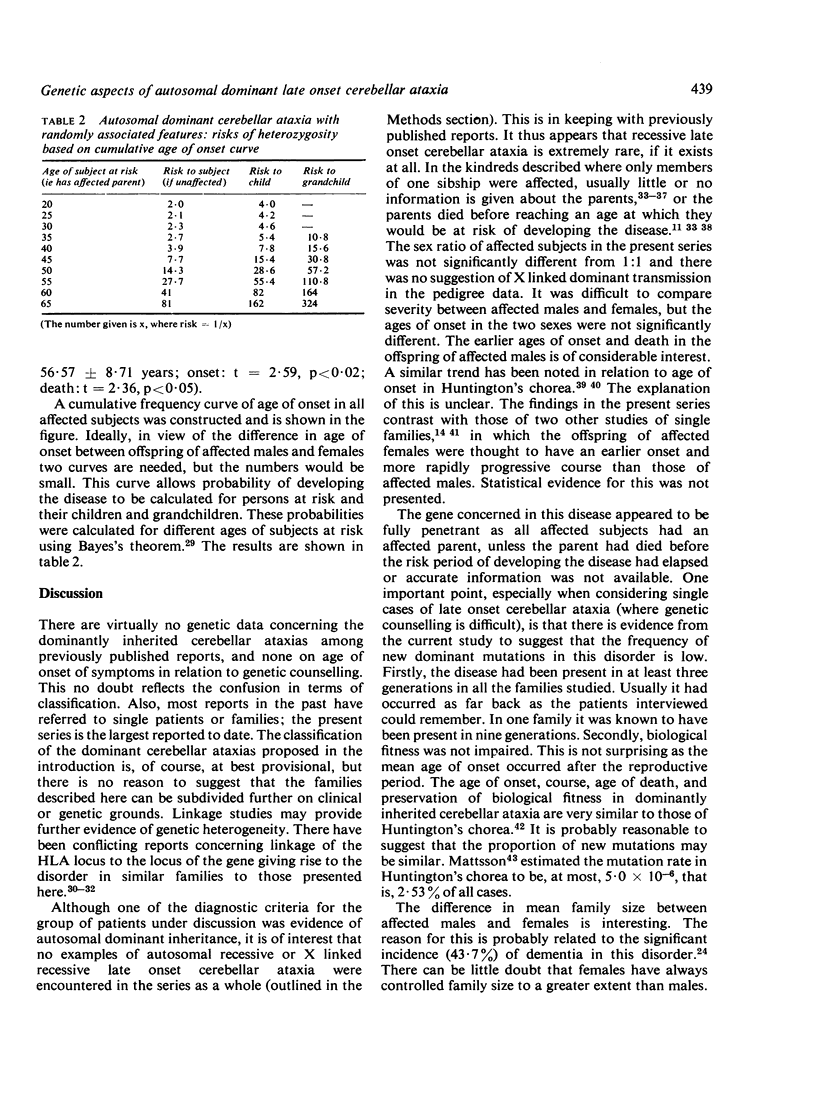
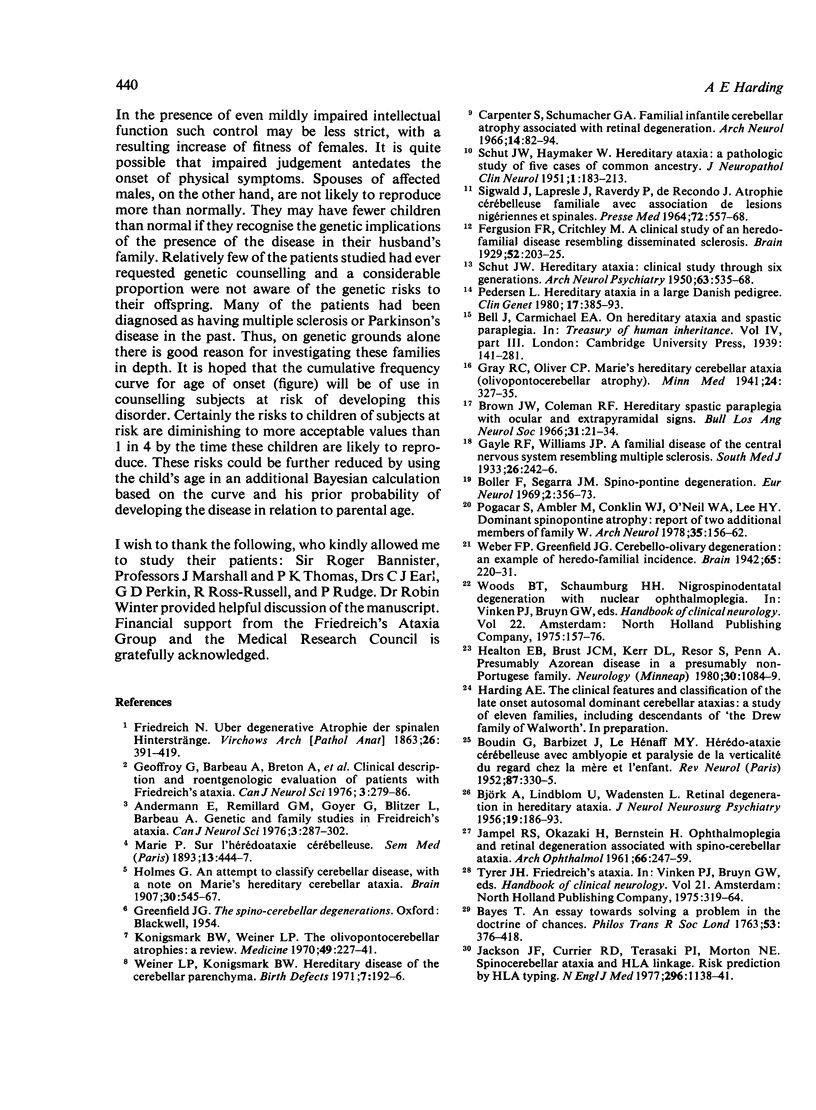
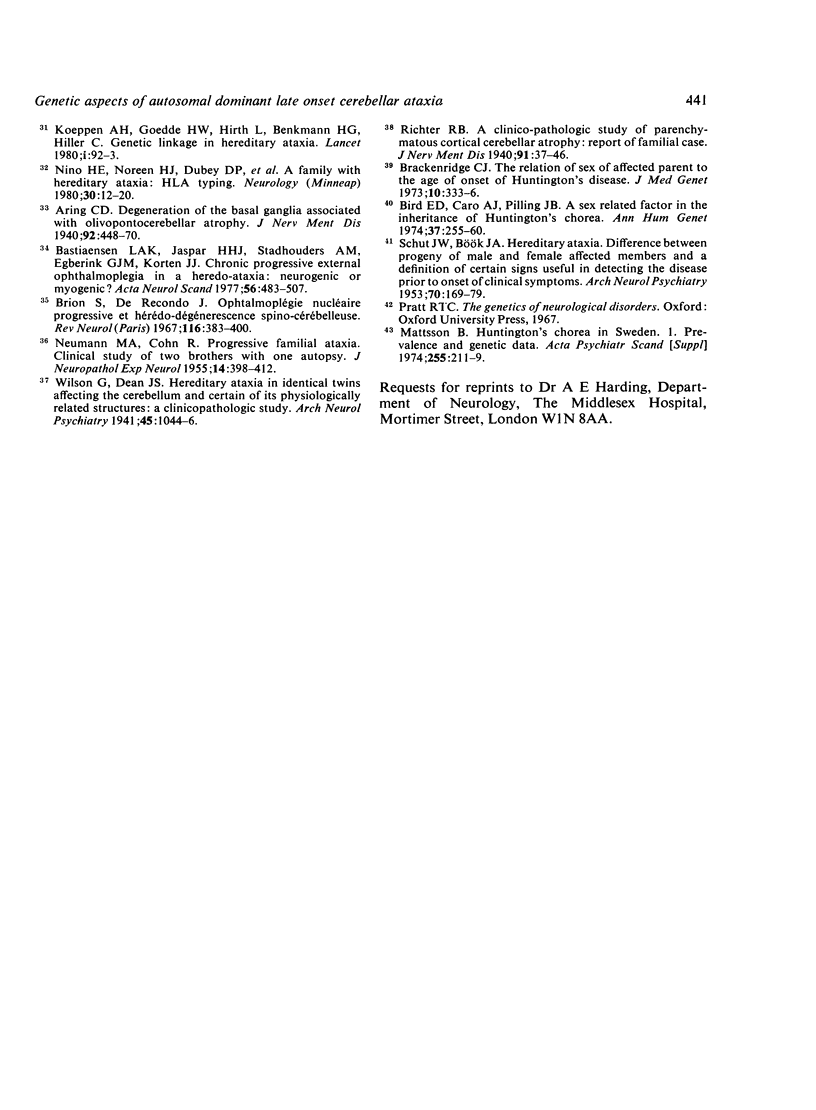
Selected References
These references are in PubMed. This may not be the complete list of references from this article.
- Andermann E., Remillard G. M., Goyer C., Blitzer L., Andermann F., Barbeau A. Genetic and family studies in Friedreich's ataxia. Can J Neurol Sci. 1976 Nov;3(4):287–301. doi: 10.1017/s0317167100025476. [DOI] [PubMed] [Google Scholar]
- BJORK A., LINDBLOM U., WADENSTEN L. Retinal degeneration in hereditary ataxia. J Neurol Neurosurg Psychiatry. 1956 Aug;19(3):186–193. doi: 10.1136/jnnp.19.3.186. [DOI] [PMC free article] [PubMed] [Google Scholar]
- BOUDIN G., BARBIZET J., LE HENAFF M. Y. Hérédo-ataxie cérébélleuse avec amblyopie et paralysie de la verticalité du regard chez la mère et l'enfant. Rev Neurol (Paris) 1952;87(4):330–335. [PubMed] [Google Scholar]
- Bastiaensen L. A., Jaspar H. H., Stadhouders A. M., Egberink G. J., Korten J. J. Chronic progressive external ophthalmoplegia in a heredo-ataxia: neurogenic or myogenic? A clinical, neuropathological and submicroscopic study. Acta Neurol Scand. 1977 Dec;56(6):483–507. doi: 10.1111/j.1600-0404.1977.tb01455.x. [DOI] [PubMed] [Google Scholar]
- Bird E. D., Caro A. J., Pilling J. B. A sex related factor in the inheritance of Huntington's chorea. Ann Hum Genet. 1974 Jan;37(3):255–260. doi: 10.1111/j.1469-1809.1974.tb01833.x. [DOI] [PubMed] [Google Scholar]
- Boller F., Segarra J. M. Spino-pontine degeneration. Eur Neurol. 1969;2(6):356–373. doi: 10.1159/000113812. [DOI] [PubMed] [Google Scholar]
- Brackenbridge C. J. The relation of sex of affected parent to the age at onset of Huntington's disease. J Med Genet. 1973 Dec;10(4):333–336. [PMC free article] [PubMed] [Google Scholar]
- Brion S., De Recondo J. Ophtalmoplégie nucléaire progressive et hérédo-dégénérescence spino-cérébelleuse. Etude d'un cas anatomo-clinique. Rev Neurol (Paris) 1967 May;116(5):383–400. [PubMed] [Google Scholar]
- Brown J. W., Coleman R. F. Hereditary spastic paraplegia with ocular and extra-pyramidal signs. (A clinical pathologic study of a family). Bull Los Angeles Neurol Soc. 1966 Jan;31(1):21–34. [PubMed] [Google Scholar]
- Carpenter S., Schumacher G. A. Familial infantile cerebellar atrophy associated with retinal degeneration. Arch Neurol. 1966 Jan;14(1):82–94. doi: 10.1001/archneur.1966.00470070086010. [DOI] [PubMed] [Google Scholar]
- Geoffroy G., Barbeau A., Breton G., Lemieux B., Aube M., Leger C., Bouchard J. P. Clinical description and roentgenologic evaluation of patients with Friedreich's ataxia. Can J Neurol Sci. 1976 Nov;3(4):279–286. doi: 10.1017/s0317167100025464. [DOI] [PubMed] [Google Scholar]
- Healton E. B., Brust J. C., Kerr D. L., Resor S., Penn A. Presumably Azorean disease in a presumably non-Portuguese family. Neurology. 1980 Oct;30(10):1084–1089. doi: 10.1212/wnl.30.10.1084. [DOI] [PubMed] [Google Scholar]
- JAMPEL R. S., OKAZAKI H., BERNSTEIN H. Ophthalmoplegia and retinal degeneration associated with spinocerebellar ataxia. Arch Ophthalmol. 1961 Aug;66:247–259. doi: 10.1001/archopht.1961.00960010249017. [DOI] [PubMed] [Google Scholar]
- Jackson J. F., Currier R. D., Terasaki P. I., Morton N. E. Spinocerebellar ataxia and HLA linkage: risk prediction by HLA typing. N Engl J Med. 1977 May 19;296(20):1138–1141. doi: 10.1056/NEJM197705192962003. [DOI] [PubMed] [Google Scholar]
- Koeppen A. H., Goedde H. W., Hirth L., Benkmann H. G., Hiller C. Genetic linkage in hereditary ataxia. Lancet. 1980 Jan 12;1(8159):92–93. doi: 10.1016/s0140-6736(80)90514-0. [DOI] [PubMed] [Google Scholar]
- Konigsmark B. W., Weiner L. P. The olivopontocerebellar atrophies: a review. Medicine (Baltimore) 1970 May;49(3):227–241. doi: 10.1097/00005792-197005000-00003. [DOI] [PubMed] [Google Scholar]
- Mattsson B. Huntington's chorea in Sweden. Acta Psychiatr Scand Suppl. 1974;255:211–220. doi: 10.1111/j.1600-0447.1974.tb08909.x. [DOI] [PubMed] [Google Scholar]
- NEUMANN M. A., COHN R. Progressive familial ataxia; clinical study of two brothers with one autopsy. J Neuropathol Exp Neurol. 1955 Oct;14(4):398–412. [PubMed] [Google Scholar]
- Nino H. E., Noreen H. J., Dubey D. P., Resch J. A., Namboodiri K., Elston R. C., Yunis E. J. A family with hereditary ataxia: HLA typing. Neurology. 1980 Jan;30(1):12–20. doi: 10.1212/wnl.30.1.12. [DOI] [PubMed] [Google Scholar]
- Pedersen L. Hereditary ataxia in a large Danish pedigree. Clin Genet. 1980 Jun;17(6):385–393. doi: 10.1111/j.1399-0004.1980.tb00168.x. [DOI] [PubMed] [Google Scholar]
- Pogacar S., Ambler M., Conklin W. J., O'Neil W. A., Lee H. Y. Dominant spinopontine atrophy. Report of two additional members of family W. Arch Neurol. 1978 Mar;35(3):156–162. doi: 10.1001/archneur.1978.00500270038008. [DOI] [PubMed] [Google Scholar]
- SCHUT J. W., BOOK J. A. Hereditary ataxia; difference between progeny of male and female affected members and a definition of certain signs useful in detecting the disease prior to onset of clinical symptoms. AMA Arch Neurol Psychiatry. 1953 Aug;70(2):169–179. [PubMed] [Google Scholar]
- SIGWALD J., LAPRESLE J., RAVERDY P., RECONDO J. ATROPHIE C'ER'EBELLEUSE FAMILIALE AVEC ASSOCIATION DE L'ESIONS NIG'ERIENNES ET SPINALES. Presse Med. 1964 Feb 26;72:557–562. [PubMed] [Google Scholar]
- Weiner L. P., Konigsmark B. W. Hereditary disease of the cerebellar parenchyma. Birth Defects Orig Artic Ser. 1971 Feb;7(1):192–196. [PubMed] [Google Scholar]


